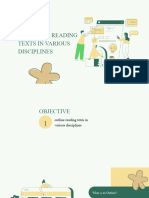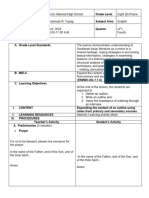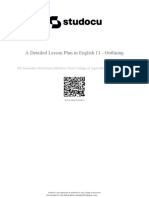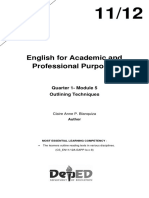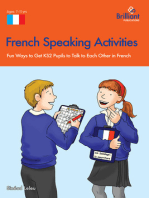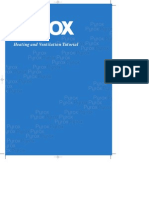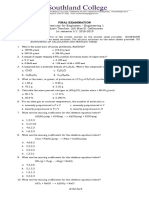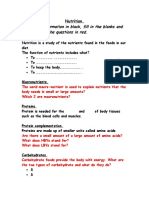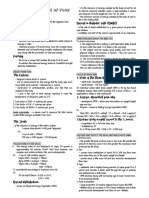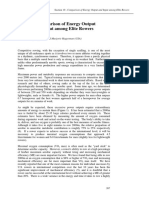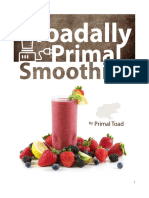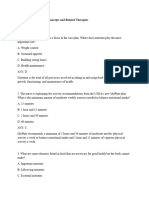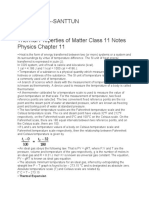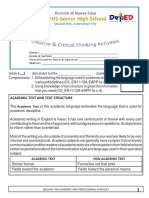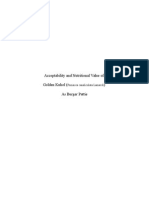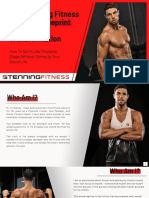Outlining LP
Uploaded by
Jesica EspelitaOutlining LP
Uploaded by
Jesica EspelitaA Detailed Lesson Plan
in
English – Grade 11
(English for Academic and Professional Purposes)
I. LEARNING OBJECTIVES / COMPETENCIES
A. Outline reading texts in various disciplines
1. Define an outline
2. Identify the kinds of outline according to structure
3. Use a topic and sentence outline in selecting and organizing information
II. LEARNING CONTENT
A. Lesson: Outlining Reading Texts in Various Disciplines
B. Materials: laptop and LCD projector (if available), copy of the powerpoint presentation of the lesson
K-W-L Chart, Picture / Word Cards, Graphic Organizers (table, charts, Venn Diagram)
C. References: SLM in English for Academic and Professional Purposes (EAPP) for Grade 11, pages 8 - 28
D. Methodology: Inductive Method and 4 A’s Approach
III. LEARNING TASKS
Teacher’s Hint Teacher’s Activity Student’s Activity
A. Preliminary Good morning class! How is your day so far? Good morning Ma’am. We are fine.
Activities
That’s good to hear! So can I expect a full blast
Greeting of energy and active participation from you? Yes Ma’am.
Before we begin our lesson this morning, let us (A student leads the prayer.)
ask the guidance of our Almighty God and let Let us bow our head and feel the presence of
us enlighten our mind to completely understand the Lord.
the lesson this morning. Father God
Martha, please lead the prayer. Come be with us today,
Fill our hearts with joy,
Prayer
Fill our minds with learning,
Fill our classrooms with peace,
Fill our lessons with fun,
Fill our friendships with kindness,
Fill our school with love.
Amen
I would like to request everyone to arrange your (The students arrange their chairs and pick up
Classroom
chairs properly and make sure there are no the trashes.)
Management
trashes around you.
As I can observe, everyone is present. I’m so
Checking of
glad that everyone understands the reasons of
attendance
coming to school regularly.
B. Developmental Let’s move on to our first activity this morning. Yes ma’am.
Activities Are you ready class?
Task 1: K-W-L Chart (The students participate actively.)
I have here a K-W-L Chart. Listen to the
instructions. What I Know What I Want What I
Fill out the first and second column of this chart. to Know Learned
For the first column, write what you KNOW
about Outlining. For the second column, write
what you WANT to know about it and leave the
third column blank.
C. Motivation Task 2: A Memory to Remember: Picture /
Word Games
For our next activity, your task is to solve the
picture/word cards. You will identify the
meaning or what the pictures / words try to tell
you. It could be a word, a phrase or a sentence.
Let’s start.
1.
1. Checks and Balances
2.
2. Hairbrush
3.
3. Irritated
4.
4. I believe in you.
5.
5. Opponents
6.
6. The wrong end of the stick
7. Heart Attack
7.
8. 8. Forbidden Fruit
9. Toothpick
9.
10. Windblown
10.
Yes ma’am. There are two groups / two games.
Very good class. Do you have any observations
about the cards? What is it? (The students sort the game cards.)
Let’s sort the game cards into to two groups or
categories. The first group is 4 Pics 1 Word Game.
What do you call the first group? The second group is Rebus Puzzle / Game.
What do you call the second group? 4 Pics 1 Word Game is a word guessing game
What is a 4 Pics 1 Word Game? that presents you with four pictures and the
tasks you with guessing what specific word fits
with the theme of the photos presented.
Rebus Puzzle is a puzzle device that combines
What is a Rebus Puzzle / Game? the use of illustrated pictures with individual
letters to depict words, phrases or sentences.
D. Activity (Lesson Using Task 2 activity, let’s do Task 3 by (The students do the activity.)
Proper) completing the table. Task 3: A Memory to Write: Completing the
Table
(Main Topic) (Main Topic)
(Sub-Topics) (Sub-Topics)
1. 1.
2. 2.
Using the information from the table, 3. 3.
accomplish Task 4. 4. 4.
5. 5.
Task 4: A Memory to Treasure: Outlining
I. _____________________
a. __________________
b. __________________
c. __________________
d. __________________
e. __________________
II. _____________________
a. __________________
b. __________________
c. __________________
d. __________________
e. __________________
What is our lesson today? Our lesson today is all about Outlining.
What is an outline? An outline is a map of your essay or a blueprint.
It shows what information each section or
paragraph will contain, and in what order. Most
outlines use numbers and/or bullet points to
arrange information and convey points.
What are the importance of an outline? An outline allows a writer to categorize the main
points, to organize the paragraphs into an order
that makes sense, and to make sure that each
paragraph/idea can be fully developed.
Essentially, an outline helps prevent a writer
from getting stuck when performing the actual
writing of the essay.
Why do we need to do an outline? ✓ Your main points are on-topic and directly
support your thesis.
✓ Your main points are logically organized.
✓ Your most important ideas are emphasized,
and your less important ideas are subordinated.
✓ Your main points have enough and relevant
supporting evidence.
Outlines also help writers:
✓ Make the writing process easier since you
have a road map for your essay to follow.
✓ Break through writer’s block—for people who
struggle with writer’s block, it helps to first set up
a structure with lower stakes and less pressure.
✓ Save time writing your essay since you have
a clear, focused plan to follow for your essay.
✓ Ensure each part of your essay relates to the
essay.
How are you going to do an outline?
✓ Put the thesis statement at the top: it should
be polished and be a complete sentence.
✓ Use Roman numerals (I, II, III, IV, V, etc.) to
indicate the main points/topic sentences which
should be written in specific phrases or complete
sentences (this is the “P” or Point of PIE).
✓ Use capital letters (A, B, C, D, E, etc.) for the
major supporting details; typically, writers should
have at least two main supporting details for
each point/topic sentence (the “I” or information
of PIE providing evidence and the “E” or
explanation of PIE providing analysis).
✓ Use numbers (1, 2, 3, 4, 5, etc.) for sub-
details clarifying and specifying your main
supporting details.
What are main points? Main points (also known as main idea). Chief
point an author is making about a topic. It sums
up the author’s primary message.
What are sub-points? Sub -Points (also known as supporting details or
idea). A paragraph contains facts, statements,
examples-specifics which guide us to a full
understanding of the main idea. They clarify,
illuminate, explain, describe, expand and
illustrate the main idea and are supporting
details.
What are the types of outlines according to Types of Outlines According to Structure
structure? 1. Topic Outline
An outline that consists of a short phrase.
It provides a quick overview of topics to be
included in an essay. You are probably already
familiar with this structure. Look at a syllabus
from one of your courses. It is probably the
equivalent of a topic outline, with topics listed for
each unit, and readings and assignments under
each. After each heading in a topic outline for an
essay, a maximum of several words is used to
identify the topic or idea that will be discussed
under the given heading.
2. Sentence Outline
An outline that is done in full sentence. It
Forces part of the essay to be written out in
sentences before the first draft. Further, it
expresses the specific and complete idea that
that section of the paper will cover as part of
proving the overall thesis.
Let’s study the examples.
Topic Outline
Thesis Statement: The increased use of social
media has led to more suicides among today’s
youth--a result of cyberbullying.
I. Effects and Consequences of Cyber Bullying
A. Damage victims
1. depression
2. decrease academic performance
3. suicides
B. Counselling
1. legal consequences
2. academic consequences
II. Prevention
A. Monitoring your Child
1. keeping tabs on activity
2. limiting access to social media
B. Counselling
1. consulting a school counsellor
2. finding a mentor
3. discussing the issue
Sentence Outline
Thesis Statement: The abuse of alcohol and
drugs can affect a person economically,
psychologically, and physically.
I. Alcohol and drug abuse can affect one
economically.
A. The cost of alcohol abuse is high and
getting higher.
1. The costs of DUIs can be
enormous.
2. Alcohol costs are always rising
because of rising production costs as well as
state and local taxes.
B. The cost of drug abuse can be high.
1. Even the arrest for the possession
of a minute amount of drugs can result in high
bail and court cost.
2. The cost of drugs fluctuates
drastically according to the type of drug, its
availability, and the amount.
II. Alcohol and drug abuse can have severe
psychological effects.
A. Alcohol abuse can damage a person
psychologically.
1. Alcohol is a depressant and can
alter the personality of anyone.
2. The abuse of alcohol can lead to the
psychological addiction to alcohol.
B. Drug abuse can be detrimental to one
psychologically.
1. Drugs impair one's ability to function
normally because of the hallucinations or
numbness of "getting high."
2. Drugs can become a psychological
addiction.
By now you have gained understanding of the Task 5: Let’s Create Memories
terms and concepts of outlining in this module. Differentiate a topic outline and a sentence
The following activities will measure how much outline in terms of their structure using a Venn
you have understood the lesson. diagram.
We have here 5 stations. You need to go
around, stop in each station and do the different
tasks. I will give you 30 minutes to finish all the
stations. (Task 5 – Task 9)
E. Analysis
Task 6: Enriching My Memory
Directions: Write an outline on the given topic
using the types of outline based on structure.
Use the outline discussed previously.
1. Write a topic outline based on the given topic.
Topic: How to prevent the spread of COVID-19
2. Write a sentence outline based on the given
topic.
Topic: The Secret of Success
Let us sum up the salient points discussed in Task 7: Match to Your Memories
this lesson. Get ready to figure them out! Directions: Match the group of words in Column
Match the group of words in Column A with the A with the concept/parts of outline they refer to
concept/parts of outline they refer to in Column in Column B. Write only the letter of your choice
B. Write only the letter of your choice on the on the blank provided.
blank provided.
F. Abstraction
You have just learned about the types of Task 8: It’s My Time to Shine
outlines, and that makes you ready for more Directions: Imagine that you are being invited to
learning activities. speak in a certain occasion like birthday party,
graduation ceremony, giving sermon for a
G. Application church service, giving an inspirational message,
and others. Write an outline for your message.
You may choose between topic and sentence
outline.
(The students do their work quietly.)
Why do we need to do an outline? ✓ Your main points are on-topic and directly
support your thesis.
✓ Your main points are logically organized.
✓ Your most important ideas are emphasized,
and your less important ideas are subordinated.
✓ Your main points have enough and relevant
supporting evidence.
Outlines also help writers:
✓ Make the writing process easier since you
have a road map for your essay to follow.
✓ Break through writer’s block—for people who
struggle with writer’s block, it helps to first set up
a structure with lower stakes and less pressure.
✓ Save time writing your essay since you have
a clear, focused plan to follow for your essay.
✓ Ensure each part of your essay relates to the
H. Generalization essay.
How are you going to do an outline? ✓ Put the thesis statement at the top: it should
be polished and be a complete sentence.
✓ Use Roman numerals (I, II, III, IV, V, etc.) to
indicate the main points/topic sentences which
should be written in specific phrases or complete
sentences (this is the “P” or Point of PIE).
✓ Use capital letters (A, B, C, D, E, etc.) for the
major supporting details; typically, writers should
have at least two main supporting details for
each point/topic sentence (the “I” or information
of PIE providing evidence and the “E” or
explanation of PIE providing analysis).
✓ Use numbers (1, 2, 3, 4, 5, etc.) for sub-
details clarifying and specifying your main
supporting details.
I. Evaluation / Do Task 9. Task 9: It’s My Turn
Assessment Direction: Read and analyze the given articles
and outline them as specified. Make sure to
highlight the points of each text.
A. Topic Outline
Understanding Calories
A calorie, also known as kilocalorie, is a unit
of energy. This unit represents the energy
required to heat a kilogram of water on degree
Celsius. While people generally link the term
calories with food, it is a unit of measurement
that can be applied to any substance
possessing energy. For instance, there are 8200
calories in a liter (about one quart) of gasoline.
Calories describe the potential energy in
food to maintain bodily functions, grow or
repair tissue, and perform mechanical work
such as exercise. Food calories may take the
form of fat, carbohydrates, or proteins. Once
consumed, enzymes act on these nutrients
through metabolic glucose, and amino acids.
These molecules travel through the blood
stream to specific cells where they are
absorbed for immediate use or sent on to the
final stage of metabolism where they release
their stored energy through the process of
oxidation.
The number of calories burned during an
exercise depends on various factors body
weight and the types of exercise. For example
an individual weighing 59 kilograms (130
pounds) would expend roughly 500 calories per
hour swimming or playing table tennis. In order
to survive and maintain body weight, the
average individual requires approximately 2000
t 2500 calories per day. Gaining or losing
weight is a simple process. Add and subtract
7,700 calories over the course of time to gain
or lose a kilogram. Nutrition has nothing to do
with it. It is all about calories.
B. Sentence Outline
How can humanity address the damage
inflected on the environment?
One important development that arose
during the late twentieth century was
environmentalism. This perspective advocates
to address the growing environmental
problems. Philosophy has a significant role in
the development of environmental awareness
and action. Several ideas and perspective
regarding environmental action have merged.
One important philosophical view from
environmentalism is environmental ethics. This
is a moral approach that analyzes the
relationship between humans and the
environment. It also discusses environmental
problems caused by human activities and social
issues that impact the environment.
Have you ever thought about how your
actions affect nature? When throwing away a
piece of trash, do you reflect on what will
happen should you decide to just throw it
anywhere in your school or community? Do
you see the importance of cleaning your
surroundings, throwing trash properly,
segregating waste, and saving water?
Environmental ethics serves as a basis for
reflecting on how our actions show our regard
for nature. We often complain about the trash
scattered around our community, but what
steps have we taken to be an example of
cleanliness and order in our homes and
communities?
Environmental ethics also guides us in
upholding the welfare of the environment and
everything in it. As persons, it is our
responsibility to start with our own actions and
how they affect our immediate environment.
Have you ever taken the initiative to tidy up
your room or help clean your house? Starting
in your own home is an important step towards
becoming a more responsible steward of
nature.
Apart from individual action,
environmentalism also encourages
governments, institutions, organizations, and
corporations to commit to responsible action
for the environment. Many of the major
environmental problems we experience, such
as pollutions, deforestation, and loss of natural
resources are cause by the actions of mining
and logging companies, factories, business, and
even governments. An important part of
environmentalism is collective action
spearheaded by environmental groups that call
attention to environmental problems and
environmental abuse.
IV. Additional Activity / Assignment
Task 10: Cut, Paste and Write
Directions: Cut a news item from a newspaper. Paste the clippings on a long coupon bond and make a sentence outline of
the news. Answer the question; “How did an outline help you as a student in your daily lives?”
Prepared by:
JESICA DEL ROSARIO ESPELITA
Teacher I Applicant
You might also like
- Gabby Gains Guide: For Your Fat Loss and Muscle Building GoalsNo ratings yetGabby Gains Guide: For Your Fat Loss and Muscle Building Goals67 pages
- Lesson 5 Outlining Reading Texts in Various DisciplinesNo ratings yetLesson 5 Outlining Reading Texts in Various Disciplines25 pages
- FSE10024 Introductory Physical Science: Formula SheetNo ratings yetFSE10024 Introductory Physical Science: Formula Sheet3 pages
- L5-Outlining an Academic Text in Various DisciplinesNo ratings yetL5-Outlining an Academic Text in Various Disciplines22 pages
- Directions: in This Activity, You Are Tasked To Read The List of Words or100% (1)Directions: in This Activity, You Are Tasked To Read The List of Words or10 pages
- EAPP - Q1 - M5 - ActivitySheet5 - FOR PRINTNo ratings yetEAPP - Q1 - M5 - ActivitySheet5 - FOR PRINT13 pages
- COURS 3 - How To Outline A Text 2023-2024No ratings yetCOURS 3 - How To Outline A Text 2023-20242 pages
- English For Academic and Professional Purposes Week 5100% (1)English For Academic and Professional Purposes Week 59 pages
- Outlining Reading Texts in Various Disciplines: English For Academic and Professional PurposesNo ratings yetOutlining Reading Texts in Various Disciplines: English For Academic and Professional Purposes24 pages
- Learning: Outlining Reading Texts in Various DisciplinesNo ratings yetLearning: Outlining Reading Texts in Various Disciplines12 pages
- Module 2 Detailed Lesson Plan English 8 105629 (2)No ratings yetModule 2 Detailed Lesson Plan English 8 105629 (2)11 pages
- RW 11 12 Unit 2 Lesson 3 Writing A Topic OutlineNo ratings yetRW 11 12 Unit 2 Lesson 3 Writing A Topic Outline23 pages
- A Detailed Lesson Plan in English 11 OutliningNo ratings yetA Detailed Lesson Plan in English 11 Outlining7 pages
- EAPP Quarter 1 - Module - 5.pdf Version 1No ratings yetEAPP Quarter 1 - Module - 5.pdf Version 110 pages
- 02_Creating Reading and Writing OutlinesNo ratings yet02_Creating Reading and Writing Outlines3 pages
- RW _12_Unit 2_Lesson 3_Writing a Topic OutlineNo ratings yetRW _12_Unit 2_Lesson 3_Writing a Topic Outline23 pages
- Creating reading and writing Outlines_lesson_planNo ratings yetCreating reading and writing Outlines_lesson_plan3 pages
- 02_Creating Reading and Writing OutlinesNo ratings yet02_Creating Reading and Writing Outlines2 pages
- ME-EngRW-11-Q3-0203_PS_Writing-a-Topic-OutlineNo ratings yetME-EngRW-11-Q3-0203_PS_Writing-a-Topic-Outline27 pages
- Assessment and Agreement. Read Thoroughly With Understanding and Answer Every Activity Given. May Use Separate Sheet of Paper If NeededNo ratings yetAssessment and Agreement. Read Thoroughly With Understanding and Answer Every Activity Given. May Use Separate Sheet of Paper If Needed4 pages
- French Speaking Activites (KS2): Fun Ways to Get KS2 Pupils to Talk to Each Other in FrenchFrom EverandFrench Speaking Activites (KS2): Fun Ways to Get KS2 Pupils to Talk to Each Other in French4.5/5 (2)
- Remaking Root Modular Learning Theory: By Jason Changkyu Kim. September 2021From EverandRemaking Root Modular Learning Theory: By Jason Changkyu Kim. September 2021No ratings yet
- Chemistry For Engineers - Engineering 1 Subject Teacher: Jyll Mae B. GellecanaoNo ratings yetChemistry For Engineers - Engineering 1 Subject Teacher: Jyll Mae B. Gellecanao6 pages
- Nutrition. Write The Information in Black, Fill in The Blanks and Answer All of The Questions in RedNo ratings yetNutrition. Write The Information in Black, Fill in The Blanks and Answer All of The Questions in Red3 pages
- How To Make Coffee Loophole Coffee - The Golden Lamb 2No ratings yetHow To Make Coffee Loophole Coffee - The Golden Lamb 23 pages
- Level 4 - Chapter 10 - Nutrition For RowingNo ratings yetLevel 4 - Chapter 10 - Nutrition For Rowing17 pages
- Physics 41 Calorimetry: Determination of Specific Heat Capacity of CopperNo ratings yetPhysics 41 Calorimetry: Determination of Specific Heat Capacity of Copper2 pages
- Anime Physique Guide: Weston Stone Garland100% (3)Anime Physique Guide: Weston Stone Garland19 pages




